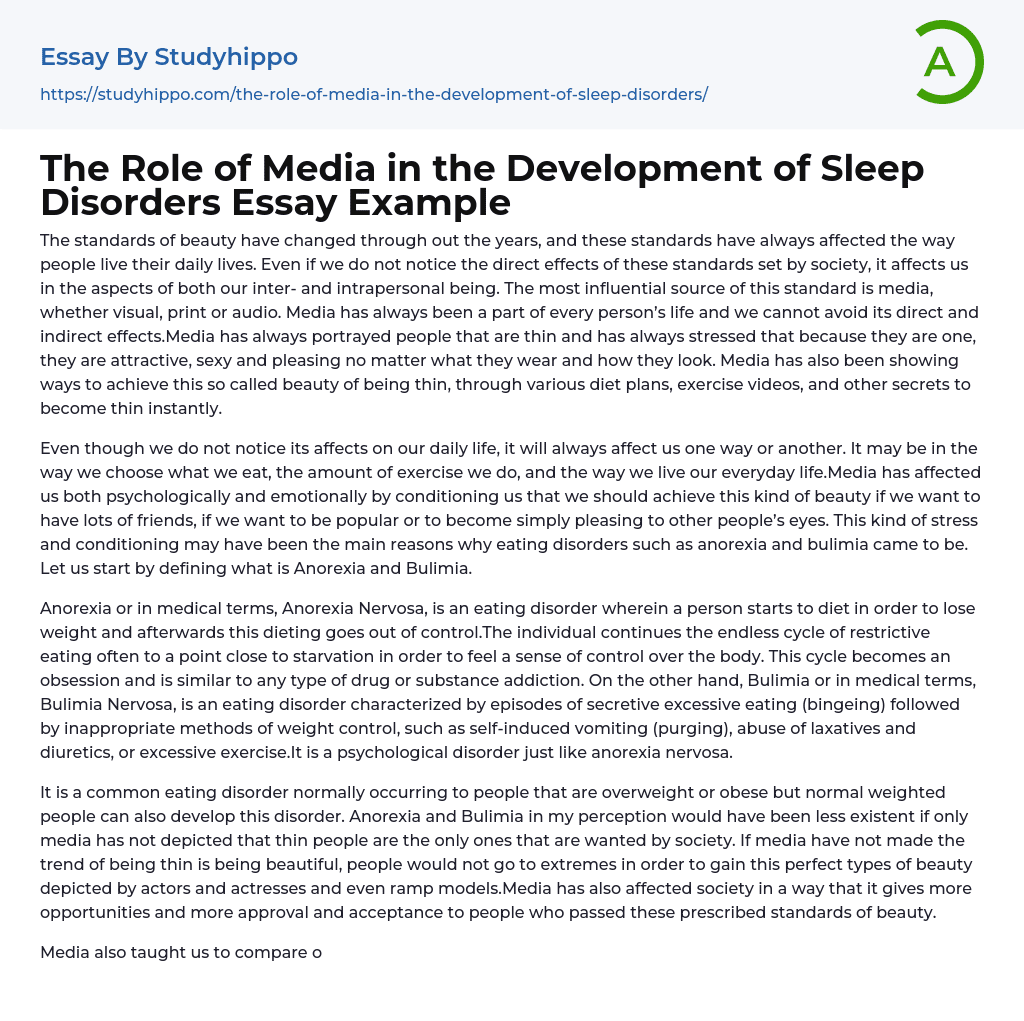

The Role of Media in the Development of Sleep Disorders Essay Example
Our personal and social well-being has been significantly affected by the evolution of beauty standards, which is largely influenced by the media. The media directly and indirectly affects us by promoting thinness as the epitome of attractiveness, sexiness, and desirability irrespective of our appearance or clothing. In addition to this, it also endorses various ways to attain this standard like diet plans, exercise videos, and quick weight loss tips.
The media's impact on our daily lives is often overlooked, despite its significant influence. It has various effects on us, such as influencing our food choices, exercise routines and lifestyle. Additionally, it can cause psychological and emotional consequences by conditioning individuals to conform to a particular beauty standard for popularity or societal expectations. This type of conditioning can increase stress levels and contribute to the development of eating disorders such as anorexia and bu
...limia. Therefore, defining these conditions and understanding their consequences is essential.
Both Anorexia Nervosa and Bulimia Nervosa are eating disorders that have notable physical and psychological consequences. Initially, those with anorexia may choose to diet to reduce weight; however, it can quickly escalate into a pattern of restrained eating that brings them perilously close to starvation. This creates a sense of control over their body similar to substance addiction. Conversely, bulimia involves binge-eating followed by inappropriate methods of weight management such as self-induced vomiting, misuse of laxatives and diuretics or excessive exercise. Psychological factors primarily cause both disorders.
Despite the common association of eating disorders with overweight or obese individuals, those of a normal weight can also develop them. In my opinion, promoting thinness as the sole desirable body type in society contributes to the hig
prevalence of anorexia and bulimia. The media perpetuates this beauty standard by portraying actors, actresses, and models on runways as idealized forms of thinness. Consequently, people go to extreme lengths to attain this prescribed appearance. Moreover, these standards have created societal biases where conformity is rewarded with more opportunities and approval.
The media's promotion of unrealistic body standards leads to harmful body image issues. If media producers had considered the long-term effects of their advertisements, these disorders could possibly have been prevented. Narcolepsy is a chronic condition affecting the central nervous system, resulting in sleep disorders due to abnormal hypocretin neuron structure and function. Symptoms include EDS, hypnagogic hallucinations, cataplexy, sleep paralysis, disturbed nocturnal sleep, automatic behavior, and vision problems such as blurred or double vision or droopy eyelids.
The treatment of narcolepsy is customized to the needs of each patient and involves both drug and non-drug approaches. The severity of symptoms, therapeutic goals, and lifestyle factors are all considered when creating an individualized treatment plan. Depending on the severity of symptoms, medications such as Dextroamphetamine, Methamphetamine Hydrochloride, Adderall, and Ritalin may be prescribed to reduce sleepiness and increase alertness.
Different types of stimulants, including Pemoline (Cylert) and Modafinil (Provigil), can help alleviate the symptoms of Narcolepsy. Phenelzine (Nardil) and Selegiline (Eldepryl), which are Monoamine Oxidase Inhibitors anti-depressants, as well as Sodium oxybate (Xyrem), are also effective in treating Excessive Daytime Sleepiness and REM Sleep disturbances associated with Narcolepsy. To treat cataplexy, anticataplectic drugs combined with selective serotonin reuptake inhibitors may be prescribed.
The treatment of narcolepsy involves non-pharmacological interventions, such as educating the patient's family and relatives about the condition to promote understanding and assist in recovery. Additionally,
consistent sleep-wake routines, dietary restrictions, physical activity, and adequate exposure to bright light are recommended behavioral methods for reducing daytime drowsiness. Counseling can also improve the overall health of patients, their families, and social connections. It is important to personalize each individual's treatment plan to promote healing.
The start of the recovery from narcolepsy lies within the individual. Rapid detection and seeking appropriate medical assistance can significantly improve the outcome and reduce the impact of the condition on our daily lives.
- Anatomy and Physiology essays
- Addiction essays
- Biodegradation essays
- Dental Care essays
- Disease essays
- Disorders essays
- Health Care essays
- Intelligence Quotient essays
- Nutrition essays
- Olfaction essays
- Public Health essays
- Women's Health essays
- World health organization essays
- Cancer essays
- Infectious Disease essays
- Lung Cancer essays
- Neurology essays
- Physical Exercise essays
- Medicine essays
- Sex essays
- Inquiry essays
- Disability essays
- Poison essays
- Action Potential essays
- Nervous System essays
- Childbirth essays
- Puberty essays
- Blood essays
- Kidney essays
- Neuron essays
- Body essays
- Glucose essays
- Sense essays
- Heart essays
- Skeleton essays
- Human Physiology essays
- Eye essays
- Immune System essays
- Muscle essays
- Skin essays
- Brain essays
- Central Nervous System essays
- Human Skin Color essays
- Digestive System essays
- Common sense essays
- Respiration essays
- alcoholism essays
- Smoking essays
- Casino essays
- Tobacco essays



